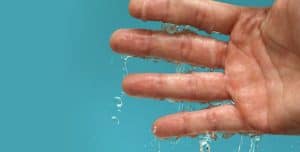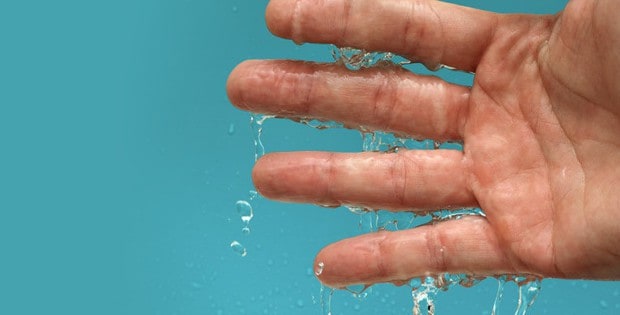
Hyperhidrosis, or excessive sweating, happens when a person sweats more than usual. Sweating is necessary to cool our bodies down, but someone who has hyperhidrosis experiences excessive sweating even when the body does not need cooled. Hyperhidrosis sufferers tend to sweat excessively in one or two locations, such as palms, feet, underarms, or head, while the rest of their body remains dry. According to the International Hyperhidrosis Association, approximately 2.8 percent of Americans are affected by hyperhidrosis.
The most common form of hyperhidrosis is called Primary Focal Hyperhidrosis. With this type of hyperhidrosis, your nerves are sent a signal and your sweat glands become overactive, even though your body has not increased in temperature. Stress and nervousness tend to make the sweating worse. The areas of the body that are often affected by this type of hyperhidrosis are the palms, feet, and sometimes your face. Secondary Generalized Hyperhidrosis is when your excessive sweating is caused by an underlying health issue such as obesity, gout, menopause, diabetes, hormone-related disorders such as PCOS, or hyperthyroidism. There are also certain medications that may lead to heavy or excessive sweating such as cholinesterase inhibitors, selective serotonin reuptake inhibitors, opioids, and tricyclic antidepressants.
Some complications from hyperhidrosis include bacterial and fungal infections. Sufferers may also have physical and emotional symptoms that may occur due to the sweating such as stained clothing, becoming self-conscious, depression, and becoming withdrawn from physical contact, for fear someone may notice their sweating. Excessive sweating may also cause you to become more aware of body odor and worried about the types of clothes you wear for the day.
Hyperhidrosis is diagnosed by a dermatologist or physician. A diagnosis of hyperhidrosis is usually made if the sufferer has sweating on both sides of the body (in the same area), experiences at least one episode of excessive sweating each week, and if the patient has excessive sweating that happens during every day activities for no clear reason. If you find yourself having any of these symptoms, you might have hyperhidrosis. While there is no cure, there are over-the-counter antiperspirants as well as prescription antiperspirants that you can apply in the area you are sweating that may help with these symptoms. Botox injections have also shown to help ease the symptoms of sweating. If you sweat excessively for no reasons and your sweating has impaired your daily activities, please give our office a call so we can explore your options and find one that is best for you!
Disclaimer: This blog provides general information and discussion about medical, cosmetic, mohs, and surgical dermatology. The words and other content provided in this blog, and in any linked materials, are not intended and should not be construed as medical advice. If the reader or any other person has a medical concern, he or she should consult with an appropriately-licensed dermatologist or other health care worker.
